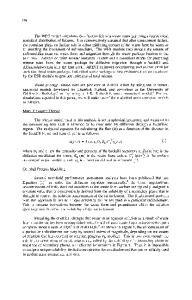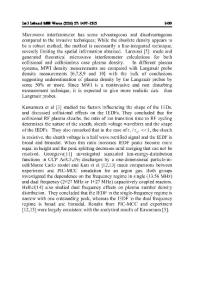Temperature-Dependent Circuit Modeling and Performance Evaluation Due to Crosstalk in Capacitively Coupled Interconnects
- PDF / 2,282,229 Bytes
- 15 Pages / 595.276 x 790.866 pts Page_size
- 79 Downloads / 341 Views
RESEARCH ARTICLE-ELECTRICAL ENGINEERING
Temperature-Dependent Circuit Modeling and Performance Evaluation Due to Crosstalk in Capacitively Coupled Interconnects of Intercalation-Doped Multilayer Graphene Nanoribbon Tajinder Kaur1
· Mayank Kumar Rai1 · Rajesh Khanna1
Received: 1 January 2020 / Accepted: 18 August 2020 © King Fahd University of Petroleum & Minerals 2020
Abstract The present work explores the temperature-dependent performance evaluation due to crosstalk in coupled interconnects of intercalation-doped multilayer graphene nanoribbons (ID-MLGNR). A temperature-dependent equivalent single conductor (ESC) model of arsenic pentafluoride (AsF5 ) ID-MLGNR is considered and is employed to analyze its crosstalk performance (i.e., crosstalk-induced noise and crosstalk-induced delay). Other metallic interconnect materials viz. mixed carbon nanotube bundles (MCB) and copper (Cu) are also analyzed in a similar manner. The temperature-dependent crosstalk performance of ID-MLGNR is compared with that of MCB and Cu, at different temperatures from 300 to 500 K. For the specified temperature range, in case of crosstalk-induced noise, the AsF5 ID-MLGNR-based long interconnects demonstrate superior performance to its MCBs and Cu counterparts. Moreover, the temperature-dependent crosstalk-induced delay is less with ID-MLGNR in comparison with both MCB and Cu interconnects. The large values of the mean free path (MFP) and conductivity of AsF5 ID-MLGNR contribute to its improved performance. In addition, the impact of variation in MFP, interlayer spacing and Fermi level is studied on the crosstalk delay performance of ID-MLGNR. From the obtained results, it is revealed that variation in these parameters results in the significant variation of 62 ps, 51 ps and 169 ps, respectively, in the odd mode (OM) crosstalk delay. Hence, for emerging nano-technology nodes (e.g., 14 nm), ID-MLGNR interconnects with its improved crosstalk performance are proposed as a potential alternative to its MCBs and Cu counterparts. Keywords Graphene nanoribbons · Interconnects · Crosstalk · ID-MLGNRs · Nanotube
1 Introduction Interconnect plays a crucial role in evaluating the operational speed and total power consumption of VLSI integrating circuits (ICs) [1]. Intensive research in the area of nanoelectronics has demonstrated the poor reliability of currently-in-use copper (Cu) interconnects with the scaling of the interconnects dimension in deep sub-micron (DSM) region [2, 3]. The inferior performance of Cu is mainly caused by its
B
Tajinder Kaur [email protected] Mayank Kumar Rai [email protected] Rajesh Khanna [email protected]
1
Department of Electronics and Communication Engineering, Thapar Institute of Engineering and Technology, Patiala, Punjab 147004, India
increasing resistivity and diminishing capability to withstand high current (due to device scaling and the upper limit of operational thermal-variation) [4]. Graphene-based carbon-nanomaterials viz. graphene nanoribbons (GNRs) and carbon nanotubes (CNTs) have emerged as
Data Loading...











